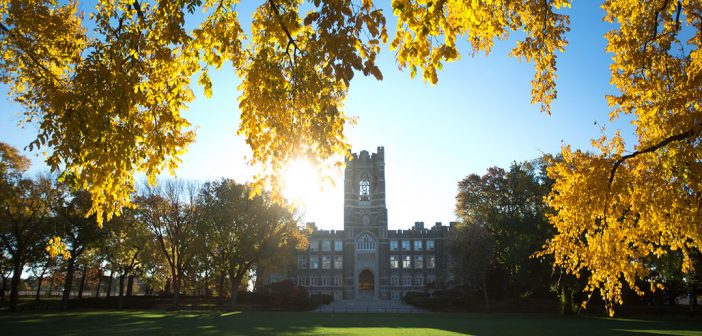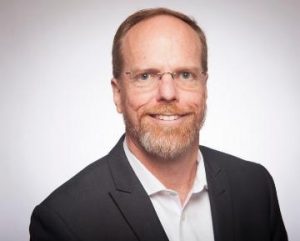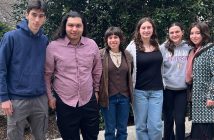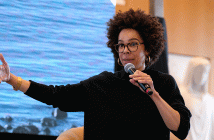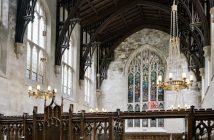Fordham’s fall classes will start on August 26, no ifs, ands, or buts.
To make this happen, the University is undertaking an unprecedented overhaul of the way it delivers academic instruction.
Dennis Jacobs, Ph.D., Fordham’s provost and senior vice president for academic affairs, said the new model, a “flexible hybrid learning environment,” will make it possible for the University to offer an excellent education to students during an uncertain time. And just as importantly, if another outbreak of COVID-19 forces New Yorkers to once again shelter in place, it will enable Fordham to shift seamlessly away from face-to-face instruction.
“None of us can anticipate how the next year will unfold in regard to the virus, because the epidemiologists are still studying and learning about it, and so much of it depends on human behavior,” Jacobs said.
“Unlike some institutions that have tried to play the crystal ball and said, ‘We need to start early and get done early,’ or, ‘We have to start late and get done late,’ what Fordham said was, ‘We wanted to create an environment that’s versatile and resilient, to deliver a quality Jesuit education under any circumstance.’”
The new model, which Jacobs announced to the University community on May 11 and detailed in the document Fordham’s Academic Approach in 2020-2021, relies on a blend of asynchronous learning, where students pursue assignments on their own time, and synchronous learning, via either in-person classroom teaching or through video platforms such as Zoom.
Planning for Social Distancing
Jacobs, one of the primary members of a task force convened by the Commission on Independent Colleges and Universities (CICU), charged with quickly developing guidelines and best practices for restarting of higher education in New York, said this approach will fulfill two distinct challenges the University expects to face when it welcomes nearly 16,000 undergraduate and graduate students back for the fall semester. For starters, it will enable Fordham to follow social distancing requirements that are expected to be mandated by the State of New York.
“We can take a class of 24 students who would normally meet once a week for three hours, split them into two groups, and have one group come for the first 90 minutes, and then the second group for the next 90 minutes, knowing that each group will also engage in asynchronous material, to balance out the course,” he said.
Many specific aspects of the plan are still in the works, and all nine of Fordham’s colleges and graduate and professional schools are working to implement it in ways that make the most sense for their students.
In addition to achieving lower campus density, Jacobs said the second concern the model addresses is the possibility that not every student or instructor will be able to attend class, due to health concerns, visa issues, or family issues related to the ongoing pandemic. Students who cannot attend classes will still be able to access asynchronous content, and synchronous content such as live lectures will be made available to them through videoconferencing technology. And if an instructor is unavailable for a time, students will still have access to the content they have prepared in advance.
Building a Flexible Model
He said the framework is akin to the bones of a skeleton, and that the University’s schools and distinct academic programs such as performing arts, lab sciences, and humanities, are currently putting flesh on it. It was borne out of open discussions held within the University community in April, and incorporated many lessons learned from the shift to online learning that took place in March.
“It would be like if you are in the middle of performing a play on Broadway, and someone says, ‘Stop! Now we’re all going to go into a TV studio and finish the play.’ How you do that on TV is very different in how you shoot and act than how you would do it on stage. That’s what we were faced with this year,” he said.
“What we’re doing now is building something flexible that can be done on stage or on TV, and therefore can accommodate all the possible scenarios that anyone might dream up for the next year.”
Doing that requires the development of content for courses that can be delivered asynchronously, a new skill for many faculty members. So this summer, professors are working with teams under the supervision of Steven D’Agustino, Ph.D., Fordham’s director of online learning, and Alan Cafferkey, director of faculty technology services, to transition elements of their course into Blackboard, the University’s learning management system.
“We start with the question, ‘What is the kind of learning you’re hoping students achieve?’ and then build out the kind of experiences in either the asynchronous or synchronous portions of the course that support that,” Jacobs said, noting that faculty will continue to refine plans for curriculum throughout the summer.
Fostering Community and Collaboration
The classroom isn’t the only aspect of University life that will change in September. In addition to the work being overseen by Jacobs’ office, 13 separate working groups from around the University are working on plans for how everything from housing and dining to the library will function once health authorities deem it safe to bring students back to campus. One group, led by Jonathan Crystal, Ph.D., vice provost, associate vice president and associate chief academic officer, is working on ways to help incoming first-year students form a sense of community over the summer that will carry on into the fall when they meet in person.
Through all the planning, Jacobs has consulted with counterparts at colleges in New York City such as Columbia, New York University, Yeshiva, and CUNY, as well as other schools throughout New York state and members of the Association of Jesuit and Colleges and Universities. Joseph M. McShane, S.J., president of Fordham, sits on the state’s New York Forward Reopening Advisory Board.
“It’s remarkable, but perhaps not surprising, how similar our situations and our challenges are,” he said, noting that many institutions’ first instincts were to try to outsmart the virus, predict what its next move would be, and then create a solution that would match it.
“What we recognized is, whatever we come up with, if we try to do that, we’re going to be wrong. The virus is going to follow a course that’s far much more complicated than any of us can understand,” he said.
Maintaining a Commitment to Cura Personalis
The clarity and stability that are built into the flexible education model are also meant to enable the University to uphold the Jesuit tenet of cura personalis, or “care for the whole person,” during challenging times.
“Today’s generation certainly connects via social media to one another. Their sense of relationship is already very much tied to using technological tools. It is not as incompatible for them to engage in relationships virtually, and I think what we’re trying to do is build out opportunities for their relationships to bud and flourish,” he said.
Professors and administrators from offices such as Counseling and Psychological Services, Disability Services, or Mission and Ministry, and Multicultural Affairs are also striving to make themselves available to students, he said.
“They’re making efforts to make contact with every student, even during these remote periods, to let them know we’re thinking about them and care deeply about them.”
Fordham will post brief updates on reopening and other University matters by end-of-business each Friday on the Fordham Coronavirus webpage.
